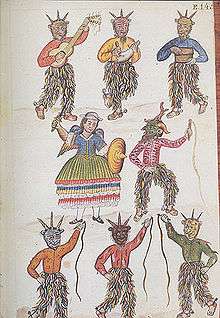Diablada
The Diablada or Danza de los Diablos (English: Dance of the Devils), is an original and typical Andean dance characterized by the mask and devil suit worn by the performers.[4][5] The dance is a mixture of religious theatrical presentations brought from Spain and Andean religious ceremonies such as the Llama llama dance in honour of the Uru god Tiw (protector of mines, lakes, and rivers),[6] and the Aymaran miners' ritual to Anchanchu (a demon spirit of caves and other isolated places in Bolivia).[7]
| La Diablada | |
|---|---|
| Stylistic origins | Andean music and Cultural Sincretism.i |
| Cultural origins | Prehispanic indigenous and Spanish traditions. |
| Typical instruments | cymbal, bass drum, trumpet, tuba, siku, quena and more depending on regional variations.iii |
| Subgenres | |
| Diablada de Oruro, Diablada Puneña | |
| Regional scenes | |
| in Bolivia: Carnaval de Oruro, Fiesta del Gran Poder, Fiesta de Urkupiña, Fiesta de Ch'utillos, Entrada de la Virgen de Guadalupe, Fiesta de San Miguel Arcangel Fiesta de la Candelaria, Carnaval de Juliaca, 28 de Julio, Tata Pancho, Festividad de la Octava del Niño Jesús, Fiesta de San Miguel Arcangel. | |
Notes
| |
Etymology
The name was consolidated in Oruro from 1789 to 1944, where masked groups which participated in parades dressed in devil costumes came to be known as Diabladas. In 1904, the first group with the label Diablada originated, the "Great Traditional Authentic Diablada Oruro," with a defined music, dress, choreography, and plot. This period culminated with the founding of new groups of Diabladas in 1944, consolidating the denomination.[5][8]
History
- Oruro, Bolivia: Its earliest record found in pre-Hispanic times, the dance of "Llama llama"in worship of the Uru god Tiw, dance subsequent ironically devoted Aymara language of the Urus dance dressed as devils, as recorded by Ludovico Bertonio. Ethnohistorical development process of disguise and the dance of Diablada fall into three periods, according to the document sent by Carnaval de Oruro to the Organization of the United Nations Educational, Scientific and Cultural Organization (Unesco) proclaimed as one of the Masterpieces of the Oral and Intangible Heritage of Humanity: Periods of 1606 to 1789, 1789 to 1944 y 1944 to 1960.
- Potosí, Bolivia: The dance could have had its beginnings in another city of modern-day Bolivia, such as in the city of Potosí, back then a miner's settlement during the Spanish conquest, from where it later spread to Oruro and other parts of the Altiplano.[9]
- Juli, Peru: The Diablada would have been introduced in 1576 to the native Lupakas people of Juli, located near Lake Titicaca in the Altiplano of present-day Puno, Peru; and from there it allegedly spread to other parts of the Spanish domain in the Americas.[10]
Native American roots
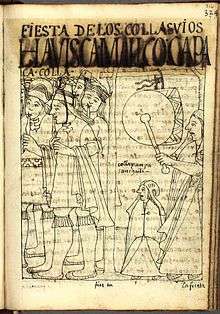
The debate about the patrimonial identity of the Diablada concerns its roots as well.[1] Chilean and Peruvian organizations suggest that since this dance is inspired in the Andean civilizations previous to the formation of the current national borders, it should belong equally to the three nations and other Andean states such as Argentina and Ecuador as well. Bolivian cultural organizations and government label this as an "unlawful cultural heritage appropriation" and consider that the declaration of the Carnaval de Oruro as one of the Masterpieces of the Oral and Intangible Heritage of Humanity gives Bolivia and the city of Oruro support on this claim.[11] Bolivian scholars such as the professor of ethnomusicology and cultural heritage, Diego Echevers Tórrez, express that the Diablada is not the mere representation of the devils in a defined space, but constitutes the cultural heritage of the city of Oruro with specific actors and environment.[12]
Aymaran roots theory
The scholars who defend the theory of Juli (Peru) identify the roots of this dance with the Aymaran traditions of the Lupakas. Based on the written accounts of 16th century historian and writer Inca Garcilaso de la Vega, the Lupaka natives of Juli in the year 1576 presented their version of the Autos Sacramentales taught to them by Spanish Jesuit priests.[10] The director of the cultural group Yuyachkani of Peru, Miguel Rubio Zapata, during an interview in 2007 with the Punean mask maker, Edwin Loza Huarachi, proposes linking the Diablada Puneña with the myth of the Anchanchu, a pre-Hispanic Aymara deity.[7] Also, researchers Peter McFarren, Sixto Choque, and Teresa Gisbert state that the Diablada has roots to the Aymaran narrative of the Myth of the Supaya.[13]
Uru roots theory
After the declaration of the Carnaval de Oruro as one of the Masterpieces of the Oral and Intangible Heritage of Humanity on 18 May 2001, the UNESCO delegated their ex-ambassador in Bolivia, Ivés de la Goublaye de Menorval, the task to be the moderator of the project and handed a form to the Bolivian authorities to be filled in coordination with historians and folklorists, such as Ramiro Condarco Morales, Mario Montaño Aragón, Fernando Cajías, Alberto Guerra Gutiérrez, Javier Romero, Elías Delgado, Carlos Condarco Santillán, Marcelo Lara, Zenobio Calizaya, Zulma Yugar, Walter Zambrana and Ascanio Nava.
The document elaborated by this group is based in the theory that the modern Diablada has roots in the ancient rituals performed 2000 years ago by the Uru civilization. The study makes reference to a deity named Tiw who was the protector of the Urus in mines, lakes and rivers and, in the case of Oruro (or Uru-uru), the owner of caves and rocky shelters. The Urus worship this deity with the dance of the devils being the Tiw himself the main character, later this name was Hispanicized as Tío (English: uncle), and as product of the syncretism, the Tiw represented the figure of the devil regretting and becoming devotee of the Virgin of Socavón.[14]
During the times of the Tahuantinsuyu, the four administrative entities known as suyus had their own representative dances during the Ito festival, a festivity once celebrated throughout the entire empire but, according to the historian José Mansilla Vázquez, who based on manuscripts of Fray Martín de Murúa, says that these festivities were outlawed during the Viceroyalty of Peru with the exception of Oruro which, for being considered an important miner city in the 16th century, counted with some privileges and the Spanish authorities looked to the other way allowing this festivity persist in this city, adapting itself later into the Spanish traditions between the Carnestolendas and the Corpus Christi becoming into the Carnaval of Oruro over the centuries.[15]

The ancient authors, Fray Martín de Murúa and Felipe Guaman Poma de Ayala make reference in their works to the different dances of the area, including the dance of the Llama llama, name given by the Aymaras to refer to the Urus dressed as dancing demons, as it was recorded by Ludovico Bertonio. This dance was performed during the Ito festivities by the representatives of the region known as Urucolla, a sub-region of the south-eastern suyu of Collasuyu located in the lake system of the Department of Oruro between the basins of the lakes Poopó and Coipasa, where the Uru civilization had the city of Oruro as their main social centre, becoming together with Nazca and Wari one of the most ancient cities in the Andean world.[15][16]
The supporters of this theory consider that the Uru mythology is reflected in the symbolism of the Diablada. The legend behind the importance of the city of Oruro as an ancient sacred place for the Urus tells the story of the chthonic deity Wari, which in the Uru language means soul (Uru: hahuari). He, after hearing that the Urus were worshiping Pachacamaj, represented by Inti, unleashed his revenge by sending plagues of ants, lizards, toads and snakes, animals considered sacred in the Uru mythology. But they were protected by the Ñusta who adopted the figure of a condor, defeating the creatures petrifying them and becoming sacred hills in the four cardinal points of the city of Oruro; these animals are also often represented in the traditional masks of the Diablada.[17][18][19]
...//...The Spanish banned these ceremonies in the seventeenth century, but they continued under the guise of Christian liturgy: the Andean gods were concealed behind Christian icons and the Andean divinities became the Saints. The Ito festival was transformed into a Christian ritual, celebrated on Candlemas (2 February). The traditional llama llama or diablada in worship of the Uru god Tiw became the main dance at the Carnival of Oruro.//...
— Proclamation of "Masterpiece of Oral and Intangible Heritage of Humanity" to the "Carnival of Oruro", UNESCO 2001
Spanish influence
One of the most referenced studies about the Diablada is the 1961 book of Julia Elena Fortún, La danza de los diablos (The dance of the devils), in which the theory of a relationship between this dance and a Catalan dance named Ball de diables, was suggested; more specifically with the elements used in the localities of Penedès and Tarragona.[20][21] Julia Elena Fortún, unlike other historians in the Peruvian side, disagrees with the idea of considering the Diablada as a product of the introduction of the autos sacramentales in the Andes, because among the ones studied by her, the thematic of the devil and his temptations was not contemplated.[22]
Autos sacramentales Theory
In 2003, the newspaper Correo and José Morales Serruto, coordinator of cultural activities of the Asociación Nativa Puno (Native Association Puno), suggested that the dance of the Diablada was originated in the Peruvian city of Juli during a representation of the autos sacramentales in the year 1576 to the Aymaran kingdom of the Lupacas.[10]
Historian Mercedes Serna observes that as soon as the Spanish conquest of the Inca Empire was achieved, there was a sudden increase in the amount of Autos Sacramentales presented in the Spanish colonies. Jose Miguel Oviedo records that by the year 1560 contests were held for religious theatrical presentations.[24] This representation was documented in the 17th century book Comentarios Reales of Inca Garcilaso de la Vega where it reads:[24]
The argument about those words of the book of Genesis: "I shall put enmities between you and the woman, etc... and she will break your head herself". Being represented by young Indians and boys in a town named Sulli. And in Potosí a dialog of faith was recited, for which more than twelve thousand Indians were present. In the Cuzco another dialog was represented about the Child Jesus, where all the greatness of that city was felt. Other was represented in the city of Kings, in front of the chancellorship and all the nobility of the city and innumerable Indians...
— Inca Garcilaso de la Vega, Comentarios Reales
Garcilaso de la Vega further mentions that the Jesuit priests taught the Auto Sacramental comedy by writing it in Aymara, and the natives of Juli later presented their version of the religious dance to the priests and, later, presented a dialogue to the rest of the Spanish population in such a way that it “changed the opinion that up to that point had regarded the natives as being dumb, rude, or incapable.”[24]
This same information is used by other authors, such as the Peruvian scholar Nicomedes Santa Cruz and the Bolivian anthropologist Freddy Arancibia Andrade, to suggest that the Spanish influence was spread to Oruro from the southern Bolivian region of Potosí. Andrade considers that the Diablada recovers the steps of rebellion and combat of the ritual of Tinku mixed with the biblic vision introduced by the Spanish conquerors in the miner region of Aullagas starting in the year 1538.[9][25]
Another piece of information collected by Andrade is that in 1780 the army of Tomás Katari wore demon suits to attack the towns of Macha, Pocoata, Colquechaca, Aullagas and San Pedro de Buena Vista, giving more strength to the syncretism and represents the appearance of the tinku-devil. After the silver era in Bolivia, the miners went to Uncía to work for the tin company of Simón Iturri Patiño and during the Bolivian federal war, the miners migrated to Oruro where in 1904 they were allowed to dance for the Virgin of Socavón.[9]
Ball de diables theory
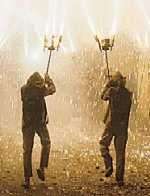
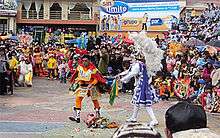
The Ball de diables has origins in a 12th-century entremés representing the struggle between the good and the evil where the figure of the archangel Saint Michael and his angels battled the forces of evil represented by Lucifer and his demons. This act was performed in the wedding banquet of the Barcelona count, Ramón Berenguer IV with the princess Petronila, daughter of the king of Aragón and Catalonia in the year 1150.[21]
In a study presented in 2005 by the Catalan scholar Jordi Rius i Mercade, member of the Ball de Sant Miquel i Diables de la Riera (board of the Ball de diables in Spain) and editor in chief of the specialized magazine El Dragabales during the Symposium of the Catalan Discovery of America, states that the traditional dances and short plays performed during the celebration of Corpus Christi in Spain were adopted by the Christian church to teach their doctrines to the Native Americans; their festivities were readapted to the new calendar and their deities were redefined acquiring demoniac forms representing the evil fighting against the divine power. According to Rius i Mercade, the Ball de diables was the most suitable for this purpose. In this study, he identifies three Latin American dances that contain similar elements to the Catalan Ball de diables; the Diablada of Oruro, Baile de Diablos de Cobán in Guatemala and Danza de los diablicos de Túcume in Peru.[21]
The Diablada of Oruro represents the tale of the struggle between the archangel Saint Michael and Lucifer, the she-devil China Supay and devils accompanying them. Ruis i Mercade suggests that this was a tale presented by the parish priest Ladislao Montealegre of the city of Oruro in 1818 inspired in the Catalan Ball de diables.[21]
Colonial history
During the colonial times in the region, from the 15th century till the first half of the 19th century, the ancient Andean beliefs were blended with the new Christian traditions. The traditions adopted new iconography and the celebrations adopted a new meaning during the Latin American wars of independence.
From the worship of the Sun to the Virgin of Candlemas

With the advent of the Inca state religion the inhabitants of the Island of the Sun (Spanish: Isla del Sol) were replaced by ministers in worship of the sun (Inti) and the city of Copacabana located in the Bolivian side of the Lake Titicaca had been repopulated by forty-two different nations of mitimaes and became one of the most important landmarks for the constant pilgrimage to the sanctuary; with the migration, two social classes were created in this area, the newcomers became Anansaya (upper) and the indigenous people Urinsaya (lower).[26]
The selection of the Virgin of the Candlemas as the patroness of Copacabana was a sign of the power structures established by the Incas in the area. In the year 1582 a frost threatened to destroy the crops, and the inhabitants decided to build an altar to a Christian figure, but there was a dispute because the Anansayas insisted to use the Virgin of the Candlemas since Francisco Tito Yupanqui had already sculpted her image while the Urinsayas wanted it use the image of Saint Bartholomew instead. But the Anansayas' wishes were imposed in the enthronement of the Virgin of Copacabana and the foundation of a brotherhood.[26]
Independence and the transition to the Carnival

The cult of the Virgin of the Candlemas, was then spread throughout the Andes reaching, Oruro and to the west to Puno. In Oruro there is a Sanctuary in honour of the Virgin of Socavón (or Sanctuary of the Virgin of the Mineshaft) who was originally the Virgin of Candlemas traditionally honoured on 2 February, like in Puno, but later the date was moved to Carnival; this transition is product of the Bolivian War of Independence. [27]
There is a legend that says that on the Saturday of Carnival in 1789 a bandit known as Nina-Nina or Chiru-Chiru was mortally wounded in a street fight and before dying he was confronted by the Virgin of the Candlemas. Some versions state that he used to worship a life-size image of the Virgin painted in a wall of a deserted house, some say that the painting miraculously appeared on the wall of the bandit's own house after his death. And the legend is concluded with the tale of the troupe of devils dancing in honour of the Virgin in the next year's Carnival. The present sanctuary in Oruro was completed in 1891.[27]
However, according to the Ph D in religious studies and Executive Director of the Wisconsin Humanities Council at the University of Wisconsin-Madison, Max Harris, this legend is related to a historical reality. During the Rebellion of Túpac Amaru II, which started in Cusco and spread along the Andean highlands, Oruro experienced a brief but bloody revolution as well. Pushed by the fear of being target of the indigenous revolution, the majority Creole on the night of Saturday, 10 February 1781, attacked the minority ruling class of the peninsular-born Spaniards (Spanish: chapetones) . With the arrival of the Indigenous army the Creoles made an alliance.[27]
On 15 February, a messenger arrived in Oruro with orders from Túpac Amaru II. He instructed his army to respect churches and clergy, to do no harm to Creoles, and to prosecute none but chapetones. And assured the victory by entering in La Paz "by Carnival (por Carnestolendas)", the Indigenous occupation of Oruro started to retreat leaving several thousands of deaths. But during March and April they launched more attacks to the city this time against the Creoles and the remaining Spaniards who unified forces to repel them.[27]
Harris observes that the Carnival of the year of 1781, fell on 24 February, placing Oruro's occupation exactly halfway between Candlemas and Carnival, making the situation in Oruro in Harris' words, "carnivalesque". Religious processions duelled with secular parades. Europeans and Creoles disguised as Indigenous, cases like a Spaniard resorting to cross-dressing tin a vain attempt to save his life and thousands of armed men in the streets of the colonial city. By 19 February people in the city regardless of the conflict continued celebrating and, throughout Carnival, the city markets were full of robbers selling the looted gold and silver back to its owners or to cholos and mestizos. By 1784 it was customary to rejoice, dance, play, and form comparsas (companies of masqueraders) for the Carnival in Oruro.[27]
Harris considers that with this background is that the legend of the Virgin of the Mineshaft in 1789 appeared favouring the rebellion as they worshiped the Virgin of Candlemas while the chapetones used to worship the Virgin of the Rosary. Under the beliefs of the revolutionaries, the Virgin of the Socavón tolerated the indigenous deities or devils and, according to Harris, if the legend is correct, by 1790, Oruro's miners had moved Candlemas to Carnival and added indigenous gods, masked as Christian devils, to the festivities.[27]
In 1818, Oruro's parish priest, Ladislao Montealegre, wrote the play Narrative of the seven deadly sins, where according to Harris and Fortún, borrowed elements of the Catalan Ball de diables like the female devil, Diablesa in the Catalan dance and China supay in the Diablada and where the Devil leads the Seven Deadly Sins into battle against the opposing Virtues and an angel. Harris suggests that Montealegre may have wanted to represent the threat of rebellion and the historical context with this play.[27]
A generation later, in 1825 after Bolivia achieved its independence, the Diablada and the Carnival adopted a new meaning for Oruro's residents. Two of the Diablada dance squads and the street from where the parade starts are named after Sebastian Pagador, one of the Creole heroes of the uprising. And the main square which is in the route of the Carnival to the Virgin of the Mineshaft temple is named Plaza 10 de febrero (10 February square) remembering the date of the uprising.[27]
Choreography
In its original form, the dance was performed to accompany a band of Sikuris, which were a group of musicians playing the Siku. Nowadays, the Diablada in the Altiplano is accompanied by band and orchestra. The uniformity of the suits brought choreographic innovation, with the layout of steps, movements, and figure designs that are not only ready to be staged in open areas such as roads, streets, and public squares; but also in places such as theaters and arenas. At the start of the krewe are Lucifer and Satan with several China Supay, or devil women. They are followed by the personified seven deadly sins of pride, greed, lust, anger, gluttony, envy, and sloth. Afterwards, a troop of devils come out. They are all led by Saint Michael, with a blouse, short skirt, sword, and shield.
During the dance, angels and demons are constantly moving around while forming somewhat complex figures such as crosses and circles. This confrontation between the two sides is eclipsed when Saint Michael appears, battles, and defeats the Devil. Both characters are dressed in heavy costumes that are highly ornate and finely wrought. The weight of the costume is more of a challenge than an obstacle for the different dance groups. The dancers often attempt to make unique and complex choreographies. The result is a colourful dance, creating a show very much appreciated by the public.
The choreography have three versions, each conformed by seven moves.[28]
First version

- Greetings: The dance starts with formations and greetings to the Virgin. The characters are displayed in two columns with the evil characters (Satan, Lucifer and China Supay) to one side, the Archangel Saint Michael to the other and the Condor in the middle. In formation they greet the rest of the devils to both sides.
- Movings: The devils start their greetings in groups of four jumping bouncing on one or other foot.
- Crossings of devil's step: S-shape crossings in couples and individuals.
- Curl: One column starts a spiral advancing to the centre then the other. Satan and Lucifer stand in the shoulders of several devils to tell their tale.
- Star: Represents the rebellion of the rest of the devils against the angel. The figure represented is an inverted Pentagram as the Sigil of Baphomet or the Signature of the Devil. Once the devils are knelled the angel enters marching.
- Star banish: Once the angel says "Oh evil spirits, get out of these places" the star is dissolved, the angel pronounces a speech and the devils representing the seven deadly sins confess towards the angel who says "Against arrogance" and the devil yells "Humility!" and regretful and with the head low retires to his row, once the sins are defeated the devils are under the command of the angel and the triumph or joy dance is interpreted.
- Squads: Formations with jump-step in rows of four, three, two, and one in front of the angel.
Second version
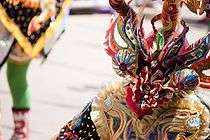
- Movings: In each column there are two leaders named guides or back-guides. The Archangel Saint Michael directs the moves with a whistle, to its signal the devils come from outside to the place of the angel while the China Supay, Satan and Lucifer switch places with him. To the second signal the devils do the same move but jumping. In the centre there is a complementary character such as the bear or condor.
- Curl: The spiral is formed and the guides or back-guides hold Satan in their shoulders who pronounces his speech. Then the band plays a slow march and the angel enters with martial step and with a cross and a mirror dazzles the devils and they return to their original places.
- Street: There is a representation of the struggle between Lucifer and the angel who wins, then Satan comes to defend his friend and is defeated too. Finally the she-devil China Spuay representing sin and flesh comes and is defeated as well. Then the angel returns to his original position.
- Squads: The China Supay and the angel on one side and Lucifer and Satan to the other dancing make switches and the devils greet them in groups of four and two.
- Star: The shape is formed and with the signal of the whistle the devils kneel, the band plays a slow march and the angel enters to the centre and the star is dissolved calling to the seven deadly sins who defeated go back to their places. Then the guides switch places.
- Chain: The dancers do a double chain and dancing holding by their arms first with the right arm then with the left one and going back to their places.
- End: The devils go to the centre in groups of four, three two and one finishing the show.
Third version
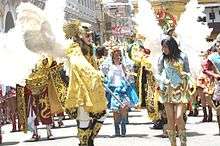
The third version is the one performed by the squad Gran Tradicional y Auténtica Diablada Oruro.[28]
Introduction Devil's walk: The devils in the left column start the movement while the ones in the right one follow them. Lucifer and Satan are named the "Kings", they are placed behind followed by the Angel and the China Supay and the band to the right side behind the second column of devils. The Kings break the formation followed by the devils, and the Condor and Bear who stay in the middle. Then the Angel and the China Supay go forward passing the middle ones by the side.
- The greet: The Kings in the front corners, the Angel and the China Supay in the back corners, and the Bear in the middle. Each perform a greeting movement.
- Curl: The devils go to the back then the left column go forward and Lucifer who is in the front meets them in the middle while the circle closes around him, he is picked up for his dialogue with Satan or to be cheered.
- Star: The devils form the star then kneel and stand up again.
- By four: The squad advances in groups of four, then breaking the formation retiring themselves to each column.
- By three: The same movement but this time in groups of three.
- By two: Same movement as the two previous ones in couples.
- By one: The devils go to the back by the side followed by the Kings, the angel and the China Supay then advance in zig zag drawing a snake, then leaving the scenario led by the Kings.
Music
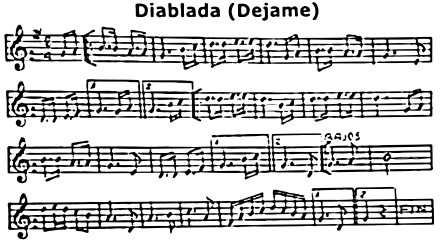
The music associated with the dance has two parts: the first which is known as the March and the second one named the Devil's Mecapaqueña, some squads play only one melody or start the Mecapaqueña in the fourth movement "by four".[28] Since the second half of the 20th century "the dialogue" is omitted focusing only in the dance.[29]
Regional variations
Puno

The Diablada Puneña is inspired in the Lupakas people when they presented their version of the Autos Sacramentales taught by the Spanish Jesuit priests in 1576 in the city of Juli in present-day Peru.[10] Nevertheless, the dance holds Native American roots from the cult of Anchanchu, a pre-Hispanic Aymara deity,[7] and the narrative of the Myth of the Supaya.[13] The dance's association with the cult of the Virgin of Candelaria stems from a popular legend that tells that in 1675, in the mine of Laikakota (located near Puno), a Spaniard by the name of José Salcedo changed his decision to destroy the miner's houses because he saw a fire coming out of the mine as a result of the Virgin Mary fighting the Devil inside the mine.
According to historian Enrique Cuentas Ormachea, until 1965 the Diablada Puneña was very different from the Diablada of Oruro when the group Los Vaporinos (formed by workers from the Peruvian Corp that worked in Lake Titicaca) began to dance in the Fiesta de la Candelaria with costumes and bands from Bolivia. Despite this, due to budget restrictions, the groups from Puno couldn't afford hiring Bolivian bands and started using their traditional groupings of Sicu-Morenos, such as the orchestra Sikuris del Barrio Mañazo (whom integrated this dance in 1922). Nowadays, the dance still maintains its differences from the Diablada of Oruro and integrates new characters such as Superman, Redskins, the Mexican, and others taken from films.[3]
Since its beginnings, the performance had a variety of changes. Originally the masks were made from plaster and the hair from baize (a coarse woollen cloth). Overtime, the mask models were influenced by Tibetan masks as well as elements from Native American cultures such as Sechin, Chavin, Nazca, and Mochica.[7] These masks were traditionally made by each dancer or bought from a Bolivian mask-maker named Antonio Vizacarra, but in 1956 the brothers Alberto and Ramón Velásquez established a workshop in Puno where masks were created and sold for the event.[30] Also, the Diablada was at first small and reserved for important religious dates in the Catholic Church. As the dance further developed, the devil dancers began to accompany groups of Sikuris, which are an assemblage of musicians that play the Siku (the traditional Andean panpipe). Among the first Sikuris that surged at this point were those of the Barrio Mañazo (1892) and Juventud Obrera (1909).[31] Nevertheless, anthropologist José María Arguedas suggests that eventually the role of the Sikuris was minimized to the point that they began to accompany the devil dancers under the new name of Sicu-Morenos. The Sicu-Morenos play with sicus, bombos, snare drums, cymbals, and triangles; and they dance Huaynos while accompanied by characters such as Caporales, minor devils, Chinas Diablas, the old man, the big-lipped negro, the Apache, the lion, the bat, the condor, the bear, the gorilla, and the giraffe (among others).[3] These characters, along with the central performance of the devil dancers and the archangel Saint Michael, make the Diablada Puneña one of the dances in the Fiesta de la Candelaria.
Oruro

The Diablada of Oruro goes back to the pre-Columbian period of the Urus who used to practice this dance in honour of the god Wari (also known as Huaricato or Huari). With the arrival of the Spanish conquerors and the evangelicalism, this divinity gradually personified the devil. The iconography depicted in the current suits, such as the snake, frog and ants, respond to the Uru mythology with the belief that if Wari wouldn't protect them they'd be destroyed by those creatures. Wari after petrifying the creatures retired to the depths of the mountains.[32]
The Bolivian anthropologist, Milton Eyzaguirre, based on a 16th-century chronicle of Bartolomé de Álvarez commented that in the Andean region of Bolivia, a cult in honour of the dead, named cupay, was practised. Over the centuries the cupay derived in supay, the figure of the devil in the modern Diablada. In pre-Columbian times the dead season started in November with the crop season, the conquerors made efforts to coincide the Andean calendar with their festivities, such as the carnival.[32]
The Diablada as is danced today in was originally the accompaniment of a theatrical play. In Bolivia there are two versions of this play preserved by Julia Elena Fortún. The oldest of these pieces belongs to the 16th century when in the parties of the city of Potosí in honour of the Virgin of Guadalupe, this play tells the story of Lucifer who, riding a horse, delivers a letter to be read to the public telling that Proserpina, the goddess of hell, was the most beautiful. A gentleman, representing the church, faces the demon defending Virgin Mary as the most beautiful. In the play after this dialogue a tournament started with fireworks and artillery shots followed by a squad of light cavalry of demons wearing black clothes and torches leading a chariot with snakes carrying Proserpina.[33]
This tradition continued in the city of Oruro over the centuries, in 1789 with the tale of the Chiru Chiru the festivity had another transformation with the introduction of the tale of the Seven deadly sins written by the parish priest Ladislao Montealegre,[32] and with the Bolivian War of Independence the parade was moved to Carnival.[27] By the 19th century the tradition had profound roots with the mining and the devotion to the Virgin of Socavón and, as it was recorded in the newspapers of that time, the dancers made offerings to the feet of the Virgin after the parade. At the beginning it was considered a working class custom but by the ends of the 19th century and beginnings of the 20th century the tradition was popularized reaching all groups of the Oruro society.[34]
The first institutionalized dance squad is the Gran Tradicional y Auténtica Diablada Oruro founded on 25 November 1904 by Pedro Pablo Corrales, followed by a Tradicional Folklórica Diablada de Oruro (1943), Diablada Círculo de Artes y Letras (1943) and the Fraternidad Artística y Cultural ´La Diablada´ (1944).[32] The squad founded by Pedro Pablo Corrales travelled to Peru in 1918 teaching to the squad Los Vaporinos the dance.[2] In 1956 this dance entered Chile brought by the squad Diablada Ferroviaria of Oruro which was invited to participate in the Tirana festivities of that year. The Chilean citizen, Gregorio Ordenes, was inspired by this visit to form the first Chilean Diablada squad Primera Diablada Servidores Virgen del Carmen in Iquique.[35]
In the year 2001, the Carnival of Oruro was declared one of the Masterpieces of the Oral and Intangible Heritage of Humanity where the Diablada along with 19 other dances were registered as part of the festivity.[6] And in the year 2004 the squad Gran Tradicional y Auténtica Diablada Oruro in its 100th anniversary received the Cóndor de Los Andes award, the highest distinction given by the Bolivian government.[36]
La Tirana
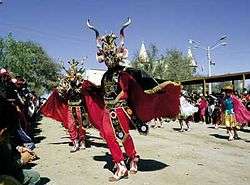
The Diablada in Chile form part of the Tirana festivities, or Fiesta de La Tirana, a festival of the northern region of that country. The town of La Tirana is located at 84 kilometres from the city of Iquique with a population of less than 400 inhabitants but during the week of the festivities, which are held in the week of 12 to 16 July, it receives nearly 120,000 visitors.[37] A documentary broadcast by Iquique TV (A Chilean television station) asserts that the dance has its roots in miners of Oruro.[38]
The sanctuary of the Virgin of Carmen was built in the region in the year 1540 and since then the festival is made in her honour in that locality with different dances.[37]
There are two kinds of squad organization:
- Ancient type: with a structure not too differenced, traditional type authority, paternalistic, religiously guarantee, The power is in one person who is representative of a familiar clan.[37]
- Modern type: has a differenced internal structure, with defined statutes and rules. Tend to be named dance society. There are managers and a director, they are responsible of the social life of the group. There is the figure of the Caporal as well, who has the authority with respect to the religious activities.[37]
The first Diablada squad in Chile was founded in the city of Iquique by Gregorio Ordenes in 1956 under the name of Primera Diablada Servidores Virgen del Carmen after the visit of the Bolivian squad Diablada Ferroviaria to the festival of that year.[35]
See also
- Diablada Puneña
- Fiesta de la Candelaria
- Carnaval de Oruro
- Diablada of Oruro
- Fiesta de La Tirana
References
- Moffett, Matt; Kozak, Robert (21 August 2009). "In This Spat Between Bolivia and Peru, The Details Are in the Devils". The Wall Street Journal. p. A1. Retrieved 4 October 2009.
- Cuentas Ormachea 1986, pp. 35-36, 45.
- Cuentas Ormachea, Enrique (23 August 2009). "Diablada: coreografía, vestimenta y música" [Diablada: choreography, clothing and music]. Los Andes (in Spanish). Puno, Peru. Retrieved 24 October 2009.
- https://books.google.com/books?id=S2E3Q62l-lUC&pg=PA63&dq=Diablada+Danza+de+Diablos&hl=en&ei=tKWGTYqXAsOV0QHg2K3CCA&sa=X&oi=book_result&ct=result&resnum=3&ved=0CDoQ6AEwAg#v=onepage&q=Diablada%20Danza%20de%20Diablos&f=false Page 63
- Real Academia Española (2001). "Diccionario de la Lengua Española – Vigésima segunda edición" [Spanish Language Dictionary - 22nd edition] (in Spanish). Madrid, Spain. Retrieved 30 November 2009.
Danza típica de la región de Oruro, en Bolivia, llamada así por la careta y el traje de diablo que usan los bailarines (Typical dance from the region of Oruro, in Bolivia, called that way by the mask and devil suit worn by the dancers).
- "Bolivia (Plurinational State of) - Information related to Intangible Cultural Heritage". UNESCO. 2001. Retrieved 3 October 2009.
The town of Oruro, situated at an altitude of 3,700 metres in the mountains of western Bolivia and once a pre-Columbian ceremonial site, was an important mining area in the nineteenth and twentieth centuries. Resettled by the Spanish in 1606, it continued to be a sacred site for the Uru people, who would often travel long distances to perform their rituals, especially for the principal Ito festival. The Spanish banned these ceremonies in the seventeenth century, but they continued under the guise of Christian liturgy: the Andean gods were concealed behind Christian icons and the Andean divinities became the Saints. The Ito festival was transformed into a Christian ritual, celebrated on Candlemas (2 February). The traditional llama llama or diablada in worship of the Uru god Tiw became the main dance at the Carnival of Oruro.
- Rubio Zapata, Miguel (Fall 2007). "Diablos Danzantes en Puno, Perú" [Dancing devils in Puno, Peru]. ReVista, Harvard Review of Latin America (in Spanish). VII (1): 66–67. Archived from the original on 1 April 2009. Retrieved 24 October 2009.
- http://www.carnavaldeoruroacfo.com/documentos/FORMULARIO%20DE%20CANDIDATURA.pdf Archived 2009-11-04 at the Wayback Machine Compilation of historians, anthropologists, researchers and folklorists about the Carnival of Oruro and La Diablada
- Arancibia Andrade, Freddy (20 August 2009). "Investigador afirma que la diablada surgió en Potosí [Investigator affirms that the ''Diablada'' emerged in Potosí]" (Interview) (in Spanish). La Paz, Bolivia. Archived from the original on 4 September 2009. Retrieved 2 October 2009.
- Morales Serruto, José (3 August 2009). "La diablada, manzana de la discordia en el altiplano [The ''Diablada'', the bone of contention in the Altiplano]" (Interview) (in Spanish). Puno, Peru: Correo. Retrieved 27 September 2009.
- "Perú dice que la diablada no es exclusiva de Bolivia" [Peru says that the Diablada is not exclusive of Bolivia]. La Prensa (in Spanish). La Paz, Bolivia: Editores Asociados S.A. 14 August 2009. Retrieved 10 December 2009.
- Echevers Tórrez 2009
- McFarren, Peter; Choque, Sixto; Gisbert, Teresa (2009) [1993]. McFarren, Peter (ed.). Máscaras de los Andes bolivianos [Masks of the Bolivian Andes] (in Spanish). Indiana, United States: Editorial Quipus. Retrieved 24 October 2009.
- A.C.F, O. 2001, p.3.
- A.C.F, O. 2001, pp.10-17.
- Guaman Poma de Ayala 1615, p.235.
- Claure Covarrubias, Javier (January 2009). "El Tío de la mina" [The Uncle of the mine] (in Spanish). Stockholm, Sweden: Arena y Cal, revista literaria y cultural divulgativa. Retrieved 13 January 2010.
- Ríos, Edwin (2009). "Mitología andina de los urus" [Andean mythology of the Urus] (in Spanish). Oruro, Bolivia: MiCarnaval.net. Archived from the original on 24 December 2009. Retrieved 13 January 2010. External link in
|publisher=(help) - Ríos, Edwin (2009). "La Diablada originada en Oruro – Bolivia" [The Diablada originated in Oruro – Bolivia] (in Spanish). Oruro, Bolivia: MiCarnaval.net. Archived from the original on 15 August 2009. Retrieved 13 January 2010. External link in
|publisher=(help) - Fortún 1961, p. 23.
- Rius I Mercade 2005
- Fortún 1961, p. 24.
- Feliciano, Wilma (22 September 2004). "El culto subversivo en "Los Diablicos de Túcume", danza dramática peruana" [The subversive cult "The little devils of Túcume", dramatic Peruvian dance] (in Spanish). Tarragona, Spain: Junta del Ball de Diables www.balldediables.org. Retrieved 8 April 2010.
- De la Vega, Garcilaso; Serna, Mercedes (2000) [1617]. "XXVIII". Comentarios Reales [Royal Commentaries]. Clásicos Castalia (in Spanish). 252 (2000 ed.). Madrid, Spain: Editorial Castalia. pp. 226–227. ISBN 84-7039-855-5. OCLC 46420337.
- Santa Cruz, 2004, p. 285.
- Salles-Reese 1997, pp. 166-167.
- Harris 2003, pp. 205-211.
- Fortún, Julia Elena (1961). "Actual coreografía del baile de los diablos" [Current choreography of the devils dance]. La danza de los diablos [The dance of the devils] (DOC). Autores bolivianos contemporáneos (in Spanish). 5. La Paz, Bolivia: Ministerio de Educación y Bellas Artes, Oficialía Mayor de Cultura Nacional. OCLC 3346627.
- Gisbert 2002, p. 9.
- Jiménez Borja, Arturo (1996). Fundación del Banco Continental para el Fomento de la Educación y la Cultura (ed.). Máscaras peruanas [Peruvian masks] (in Spanish). Lima, Peru. Retrieved 24 October 2009.
- Museo Nacional de Etnografía y Folklore (Bolivia) (2003). MUSEF (ed.). Serie anales de la reunión anual de etnología [Records of the annual reunion of ethnology series] (in Spanish). 2. La Paz, Bolivia: MUSEF. Retrieved 24 October 2009.
- "La diablada orureña se remonta a la época de los Urus precoloniales" [The Diablada of Oruro goes back to the times of the Pre-Columbian Urus]. La Razón (in Spanish). La Paz, Bolivia. 9 August 2009. Archived from the original on 13 August 2011. Retrieved 9 April 2010.
- Gisbert 2002, p. 8.
- Cajías 2009
- "El folclor de Chile y sus tres grandes raíces" [The Chile’s folklore and its three great roots] (in Spanish). Memorias Chilenas. 2004. Archived from the original on 11 September 2008. Retrieved 9 December 2009.
- "La Diablada De Oruro, máscara danza pagana" [The Diablada of Oruro, mask pagan dance] (in Spanish). 2009. Archived from the original on 14 July 2011. Retrieved 9 December 2009.
- "Danzas ceremoniales del área cultural del Norte" [Ceremonial dances of the northern cultural area] (in Spanish). Chile: Hamaycan. Archived from the original on June 9, 2009. Retrieved 8 April 2010.
- "Audiovisual que recoge el origen de la Diablada, con sus raíces en los piques mineros bolivianos, en el marco de una nueva celebración de la Fiesta de La Tirana. El documental contó con el apoyo de la Minera Collahuasi y fue estrenado en la sala de artes de la compañía. Fecha: 13 de julio del 2010". Archived from the original on 2011-03-27. Retrieved 2011-03-21.
Articles:
- Eckels, Charlene (17 October 2013). "Dance of the Devils" [Dance of the Devils]. Yareah. New York, New York. Archived from the original on 29 October 2013. Retrieved 27 October 2013.
- Cajías, Fernando (23 August 2009). "La diablada orureña ya era noticia en el siglo XIX" [The Diablada of Oruro was already news in the 19th century]. La Razón (in Spanish). La Paz, Bolivia. Archived from the original on September 27, 2009. Retrieved 10 December 2009.
- Cuentas Ormachea, Enrique (March 1986). "La Diablada: Una expresión de coreografía mestiza del Altiplano del Collao" [The Diablada: A mixed race choreographic expression of the Altiplano in the Collao]. Boletín de Lima (in Spanish). Lima, Peru: Editorial Los Pinos. year 8 (44). ISSN 0253-0015. Archived from the original (PNG) on June 16, 2010. Retrieved November 24, 2009.
- Echevers Tórrez, Diego (3 October 2009). "Sobre diablos y diabladas, A propósito de apreciaciones sesgadas" [About devils and Diabladas, speaking about biased interpretations]. La Patria (in Spanish). Oruro, Bolivia. Retrieved 8 January 2010.
- Gisbert, Teresa (December 2002). "El control de lo imaginario: teatralización de la fiesta" [The control of the imaginary: theatralization of the party] (PDF). Módulo: Estudios de caso – Session 14, Lecture 3 (in Spanish). Lima, Peru: Instituto de Estudios Peruanos. Archived from the original (PDF) on 19 July 2011. Retrieved 8 April 2010.
- Rius i Mercade, Jordi (18 January 2008). "Concomitàncies entre els balls de diables catalans i les diabladas d'Amèrica del Sud" [Concomitances between the Ball de diables and the Diabladas of South America] (in Catalan). Tarragona, Spain: Junta del Ball de Diables www.balldediables.org. Retrieved 10 December 2009.
- Thomas M Landy, "Dancing for the Virgin at La Tirana", Catholics & Cultures updated February 17, 2017
Books
- Asociación de Conjuntos del Folklore de Oruro (2001). UNESCO (ed.). Formulario de Candidatura para la proclamación del Carnaval de Oruro como Obra Maestra del Patrimonio Oral e Intangible de la Humanidad [Candidature Form for the proclamation of the Carnaval de Oruro as Masterpiece of the Oral and Intangible Heritage of Humanity] (PDF) (in Spanish). Oruro, Bolivia. Archived from the original (PDF) on 4 November 2009. Retrieved 11 January 2010.
- Fortún, Julia Elena (1961). La danza de los diablos [The dance of the devils]. Autores bolivianos contemporáneos (in Spanish). 5. La Paz, Bolivia: Ministerio de Educación y Bellas Artes, Oficialía Mayor de Cultura Nacional. OCLC 3346627.
- Guamán Poma de Ayala, Felipe (1980) [1615]. Fundacion Biblioteca Ayacucho (ed.). El Primer Nueva Corónica y Buen Gobierno [The First New Chronicle and Good Government] (in Spanish). 2. Caracas, Venezuela. ISBN 84-660-0056-9. OCLC 8184767.
- Harris, Max (2003). "The Sins of the Carnival Virgin (Bolivia)". Carnival and other Christian festivals: folk theology and folk performance. Joe R. and Teresa Lozano Long series in Latin American and Latino art and culture. Austin, United States: University of Texas Press. ISBN 978-0-292-70191-5. OCLC 52208546.
- Salles-Reese, Verónica (1997). From Viracocha to the Virgin of Copacabana: representation of the sacred at Lake Titicaca (1 ed.). Austin, United States: University of Texas Press. ISBN 978-0-292-77713-2. OCLC 34722267.
- Santa Cruz, Nicomedes (2004). LibrosEnRed (ed.). Obras Completas II. Investigación (1958-1991) [Complete Works II. Investigation (1958-1991)]. Obras completas, Nicomedes Santa Cruz (in Spanish). 2. ISBN 1-59754-014-5.
External links
| Wikimedia Commons has media related to Diablada. |
- Cultures Ministry of Bolivia (in Spanish)
- Folklore's Group Association - Oruro (in Spanish)
- National Culture Institute - Peru (in Spanish)
